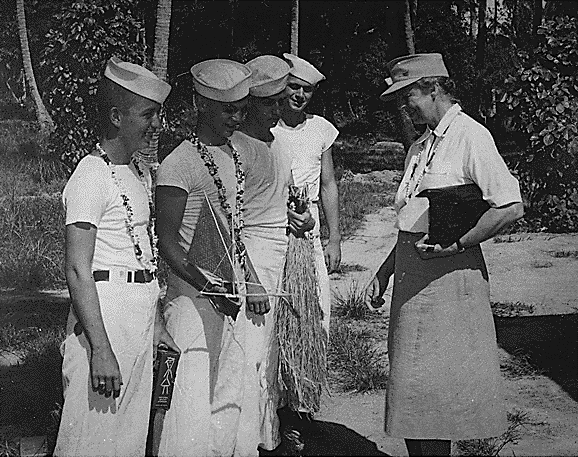
THE FIRST LADY OF WORLD WAR II:
Eleanor Roosevelt's Daring Journey to the
Frontlines and Back
The first book to tell the full story of Eleanor Roosevelt's unprecedented and courageous trip to the Pacific theater during World War II, described by a reporter at the time as "the most remarkable journey any president's wife has ever made."
In late August 1943, news broke across the United States that First Lady Eleanor Roosevelt was on the other side of the world in New Zealand. A closely guarded secret, she had left San Francisco ten days earlier aboard a military transport plane headed for the Pacific theater. As Allied forces battled the Japanese for control of the region, Eleanor spent five weeks traveling to Hawaii, New Zealand, and Australia, and making seventeen additional island stops through the South Pacific.
Driven to contribute to the war effort and to support the servicemen risking their lives in the fight, the 58-year-old First Lady set out on the most perilous undertaking of her career—a further, longer, more dangerous trip than any she had previously done. She traveled some 25,000 miles, a distance roughly equal to the earth's circumference.
The First Lady of World War II follows Eleanor as she flies on unheated transport planes and bombers, sleeps on army cots in rustic huts, dines in mess halls, travels by jeep over rough terrain to reach isolated camps, and treks through the jungle on a simulated training mission. She went bed-to-bed comforting the wounded in hospitals, toured military bases, inspected war production factories, and gave radio addresses, interviews, and speeches to standing-room-only crowds. Her schedule was so rigorous that an Australian newspaper dubbed her "Public Energy No. 1." In all, she addressed more than 400,000 troops, bringing them a message of thanks from the President.
Weighing on Eleanor as she traveled through the region was whether she would be able to overcome strong opposition to achieve her ultimate goal of the trip: getting to Guadalcanal. The island was the site of the first major offensive against the Japanese, a pivotal turning point in the war, important strategically as well as giving a much-needed morale boost to servicemen and civilians alike. Visiting Guadalcanal, which was still on the front lines, was a personal test of courage for Eleanor and a gesture of support she felt she owed to the men in uniform. But winning approval from the skeptical area commander, Admiral William F. Halsey, for a visit to an island still in the enemy's sights would require all of Eleanor’s resilience and diplomatic savvy.
Moreover, the trip occurred at a crucial time in the war. Even as men in the Pacific and other parts of the world continued to die in battle, Americans were prematurely, and in Eleanor's opinion dangerously, optimistic about the war's outcome. An important link between the fighting forces and the home front, she cautioned against complacency, using her extensive media platforms to convey her thoughts and findings to the public.
Along the way, The First Lady of World War II considers Eleanor's identity as an influential and polarizing figure. Americans then, as today, closely scrutinized presidents' wives who didn’t conform to type, but Eleanor did not let politics or public criticism intimidate her. While touring the Pacific, she used the intense media spotlight the trip generated to continue championing issues that were important to her, including racial equality and integrating the armed forces, women's greater involvement in the war effort and in broader civic life, and supporting servicemen after the war's end.
Eleanor's evolution from shy society matron to a worldwide celebrity is encapsulated in this story of the Pacific journey. Readers see a lesser-known side of her, that of adventurer, and discover how travel was a driving force in her life and career and a key factor in her success as First Lady. Eleanor's travels also illuminated her unique relationship with FDR, enhancing a model political partnership. He actively encouraged her solo roaming, unusual for women at the time, and was proud of her ability to connect with people. Because of the knowledge she gleaned from a vast number of everyday Americans, the government better understood their needs and concerns.
While in the Pacific, whether greeting dignitaries at state receptions or troops in a convoy on a dusty road in the outback, Eleanor was the dynamic, engaging woman the world had come to admire during her decade as First Lady. Privately, though, she was haunted by the immense suffering she witnessed in military hospitals and by the staggering number of men wounded in body and mind. The stark reminder of the human cost of war reinforced her determination to help secure a lasting peace after World War II.
As this book illustrates, the groundbreaking Pacific trip was emblematic of Eleanor and her life—courageous, curious, compassionate, charismatic—and demonstrated how dramatically she transformed the role of First Lady. Her daring trek into a theater of war sprawling over vast ocean distances and under arduous conditions still stands as "the most remarkable journey any president’s wife has ever made."

"This action-packed and suspenseful wartime drama vividly captures the selfless grit and tenderness of Eleanor Roosevelt’s battle-zone leadership. By revealing as never before the tensions of our gutsiest First Lady’s perilous transpacific odyssey, Shannon McKenna Schmidt shows why for the first time in her career Eleanor came home exhausted--thirty pounds lighter--from comforting the wounded and energizing ravaged teenage combat veterans to bring back from bomb-blasted islands, New Zealand, and Australia, the hardest truths of the bloodiest world war."
—David Michaelis, New York Times bestselling author of ELEANOR
Where to Purchase
The First Lady of World War II
Hardcover
Audiobook

Bora Bora
Honolulu, Hawaii


New Caledonia
Guadalcanal


A hospital in the South Pacific
Rotorua,
New Zealand


Christmas Island
Lookout tower, Christmas Island


Visiting with troops in the Pacific
Aboard the USS Oklahoma, Pearl Harbor

Photographs are all in the public domain and © as follows, top to bottom: FDR Library (FDRL), U.S. National Archives (USNA), FDRL, USNA, USNA, USNA, FDRL, USNA, FDRL, U.S. Navy/Digital Archives of Hawaii
